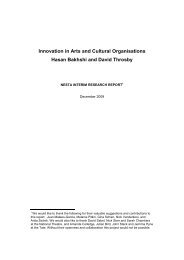Rumbling on performativity_Frits Simon
Rumbling on performativity_Frits Simon
Rumbling on performativity_Frits Simon
You also want an ePaper? Increase the reach of your titles
YUMPU automatically turns print PDFs into web optimized ePapers that Google loves.
the importance which in the prescriptive and descriptive rhetoric is attached to a<br />
stable (read: normal) state of things. The c<strong>on</strong>sequence of this point of departure is that<br />
a dualism is introduced as if an organizati<strong>on</strong> or a pers<strong>on</strong> (e.g. an adviser) is able to step<br />
out of a normal situati<strong>on</strong>, is able to organize some sort of learning process and then is<br />
able to step back into the altered state. From a complex resp<strong>on</strong>sive process-perspective<br />
this is - as menti<strong>on</strong>ed before - called the doubling fallacy (Stacey, 2007). The<br />
fallacy implies to assume that change is disc<strong>on</strong>nected from everyday organizati<strong>on</strong>al or<br />
pers<strong>on</strong>al life, although at the end of the day change may indeed have some c<strong>on</strong>sequences<br />
for this everyday life.<br />
I assume that any<strong>on</strong>e who has been part of an organizati<strong>on</strong> and change programmes<br />
knows that this dualism is an illusi<strong>on</strong>. My experience - as stipulated in chapter 3 - with<br />
working in teams to design reform together, exemplifies that even if ‘stepped out-situati<strong>on</strong>s’<br />
are created, the same ideological battles are fought, but then hidden in designoriented<br />
language. If an organizati<strong>on</strong> is to be described as unstructured and ever<br />
changing, things are and remain unclear (Homan, 2005). Change programmes are part<br />
of an <strong>on</strong>-going process of sense making by people within their organizati<strong>on</strong>al c<strong>on</strong>text.<br />
Change mixes c<strong>on</strong>versati<strong>on</strong>, routines, sp<strong>on</strong>taneity, cooperati<strong>on</strong>, c<strong>on</strong>flict and power<br />
(Groot, 2010b). From a complex resp<strong>on</strong>sive process-perspective change, whether<br />
emergent, incremental or disruptive, is our normal state of being, but slides into<br />
invisibility in what is called the dominant modernistic discourse (Chia, 1995; Toulmin,<br />
1990) as propagated by descriptive or descriptive theories of change.<br />
In an ever changing social reality which is brought about in the <strong>on</strong>-going interacti<strong>on</strong>s<br />
of people, <strong>on</strong>e may w<strong>on</strong>der whether effective change in the way it is proclaimed by<br />
theories of change, ever will be present.<br />
If change is real in its c<strong>on</strong>tinuity, my supposed role of a corporate jester and the doubts<br />
about the manageability of an organizati<strong>on</strong> make it obvious to reflect up<strong>on</strong> my role as<br />
a jester from a point of view in which manageability and the belief in planning of<br />
effective change is being questi<strong>on</strong>ed.<br />
The return of the jester?<br />
If it is true that nowadays there is again a growing amount of corporate jesters (Otto,<br />
2001) then my positi<strong>on</strong>, as I became to reflect up<strong>on</strong> my positi<strong>on</strong> in my narrative about<br />
the internal branding programme, is to be explored in regard to this growing presence<br />
of jesters. Apparently, nowadays corporati<strong>on</strong>s again need some sort of an adviser to<br />
challenge them or to think outside the box, but why a jester? “The Corporate Fool is a<br />
manifesto for a new business professi<strong>on</strong>al: an indispensable amalgam of roles which<br />
stimulates effective change and resoluti<strong>on</strong> in this foolish world.” (Firth and Leigh, 1998:<br />
43). What may a jester’s role be in a foolish world by abstaining from the possibility of<br />
planned effective change will be taken up again after some reflecti<strong>on</strong>s <strong>on</strong> the process<br />
of drafting the performance agreements.<br />
5. Drafting performance agreements: gestures of a c<strong>on</strong>temporary jester | 131



